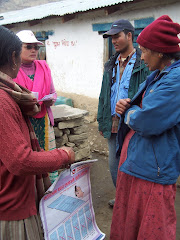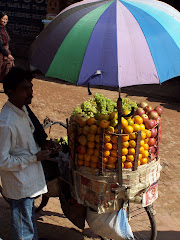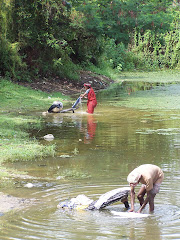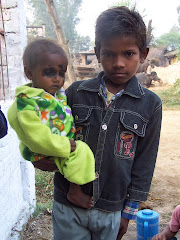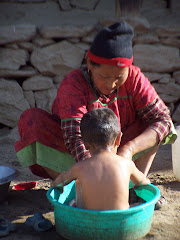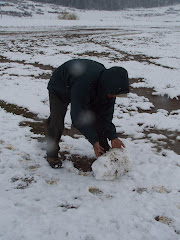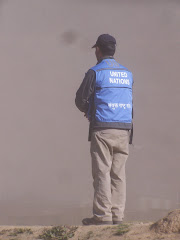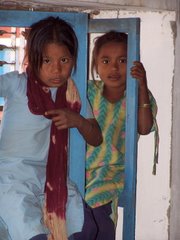 There are many ways to travel, or transport things, in Nepal, all with different levels of comfort or more or less hard to the person driving.
There are many ways to travel, or transport things, in Nepal, all with different levels of comfort or more or less hard to the person driving.For example, it is possible to get a lift with one of the many tractors like these two brave boys trying to stay warm under a blanket. When not carrying other loads, this kind of transport can carry a lot of workers.
 In the Terai, where Nepalgunj is, the rickshaw is by far the most common transport for just about anything. The rickshaw pullers often spent most of their lives in the rickshaw. They usually rent it and therefore only make money once they've made enough each day to cover the rent. I do not know what the rent is, but knowing that at least the Nepalis never pay more than a couple of rupees they are definitely not making a lot of money. Most people treat the rickshaw pullers with very little respect too. Calling a rickshaw, for any purpose is done by just screaming, eehh rickshaw... I for my part, don't think the rickshaw pullers are treated even with a fraction of the respect they deserve, and often they are but teenagers.
In the Terai, where Nepalgunj is, the rickshaw is by far the most common transport for just about anything. The rickshaw pullers often spent most of their lives in the rickshaw. They usually rent it and therefore only make money once they've made enough each day to cover the rent. I do not know what the rent is, but knowing that at least the Nepalis never pay more than a couple of rupees they are definitely not making a lot of money. Most people treat the rickshaw pullers with very little respect too. Calling a rickshaw, for any purpose is done by just screaming, eehh rickshaw... I for my part, don't think the rickshaw pullers are treated even with a fraction of the respect they deserve, and often they are but teenagers.

 Then there are bicycles, also used a lot, and more often than not, by at least two people. Sometimes there are no roads or bridges, and then a bicycle comes in handy - it is much easier to get a bike on the ferry than a motorbike, I know for sure and I have written about it below...
Then there are bicycles, also used a lot, and more often than not, by at least two people. Sometimes there are no roads or bridges, and then a bicycle comes in handy - it is much easier to get a bike on the ferry than a motorbike, I know for sure and I have written about it below...
 In the Terai, where Nepalgunj is, the rickshaw is by far the most common transport for just about anything. The rickshaw pullers often spent most of their lives in the rickshaw. They usually rent it and therefore only make money once they've made enough each day to cover the rent. I do not know what the rent is, but knowing that at least the Nepalis never pay more than a couple of rupees they are definitely not making a lot of money. Most people treat the rickshaw pullers with very little respect too. Calling a rickshaw, for any purpose is done by just screaming, eehh rickshaw... I for my part, don't think the rickshaw pullers are treated even with a fraction of the respect they deserve, and often they are but teenagers.
In the Terai, where Nepalgunj is, the rickshaw is by far the most common transport for just about anything. The rickshaw pullers often spent most of their lives in the rickshaw. They usually rent it and therefore only make money once they've made enough each day to cover the rent. I do not know what the rent is, but knowing that at least the Nepalis never pay more than a couple of rupees they are definitely not making a lot of money. Most people treat the rickshaw pullers with very little respect too. Calling a rickshaw, for any purpose is done by just screaming, eehh rickshaw... I for my part, don't think the rickshaw pullers are treated even with a fraction of the respect they deserve, and often they are but teenagers.
The rickshaws are however not the only thing being overloaded, trucks and carts are loaded until they almost burst, no difference is made as to what kind of force is pulling the load. Mostly the carts are pulled by buffaloes, but it is not uncommon to see the hand pulled carts still.
We are lucky that we have cars, and that we are allowed to drive them ourselves, even privately (many other NGOs have drivers and even though comfortable it limits your freedom I think). However even with a car of your own, there are a lot of things that happens unforeseen. To the left below we were stuck in landslides, for 23 hours, and had to spend most of the night in the car. We are using the time to dry our clothes that were soaked by the same rain causing the landslide. To the right, Jeppe is waiting in line to get diesel. There had been strikes for weeks and all traffic to the capital was cut off, i.e. no fuel came in to the city. We waited for 15 hours...
For those not having cars, or living on the country side where there are no roads good enough for much else than walking, buffaloes are a common way of travel. It is slow, but it will get you where you are going.


The motor driven public transport on the highway, is often overcrowded and slow. Since it is a lot cheaper to travel on the roof, many do so. On the picture below though, the reason for travelling on the roof has more to do with being seen and having a change to chant slogans while travelling. They are Maoist students going to yet another mass meeting... To the right is a over crowded tempo (taxi) going up the mountains to Tansen. Since it's been raining and landslides might happen, o they just slip over the edge, it is probably safest to be hanging out the back. In that way they can always jump off.
Travelling on buses often means waiting for hours, due to landslides, flat tires or whatever. But when it starts moving, you better be quick to get back on board because they are always in a hurry to the next break down, landslide, chakka jam...

 Then there are bicycles, also used a lot, and more often than not, by at least two people. Sometimes there are no roads or bridges, and then a bicycle comes in handy - it is much easier to get a bike on the ferry than a motorbike, I know for sure and I have written about it below...
Then there are bicycles, also used a lot, and more often than not, by at least two people. Sometimes there are no roads or bridges, and then a bicycle comes in handy - it is much easier to get a bike on the ferry than a motorbike, I know for sure and I have written about it below...It is very common to see a whole family riding on a bicycle, the women sitting behind, always on the side and often with a baby and big bags. Even the school "bus" are pulled by bikes, and though they look small, they take an impressive amount of kids in
them, hanging all the school bags on the outside.



















